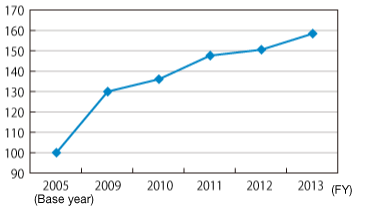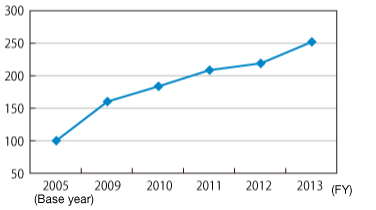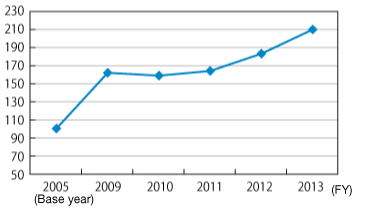Environmental Preservation
Environmental accounting
Yokohama Rubber conducts environmental accounting that totals investments and costs related to environmental protection, energy conservation, and recycling in order to calculate the cost-effectiveness of investments and expenses.
While Yokohama Rubber has released environmental accounting data up to FY2009, at FY2013, YRC restart environmental accounting with head office and domestic production site as boundary, bases in reference to the guidelines of the Ministry of the Environment.
Environmental conservation costs
(millions of yen)
| Item | Major initiatives | FY2013 | ||
|---|---|---|---|---|
| Business area costs | Investments | Costs | ||
| Pollution prevention costs | Setting industrial water and wastewater treatment tank above ground/ Renewal for boiler smokestacks, etc. | 81 | Note | |
| Global environmental conservation costs | Adopting PM motors, updating air conditioning and temperature control equipment, etc. | 596 | Note | |
| Resource recycling costs | Costs related to waste segregation and processing | 0 | 380 | |
| Upstream and downstream costs | Expenses for reuse of tire bladders and plastics liners for rubber take-up | 0 | 42 | |
| Management activity costs | EMS maintenance, management, and information disclosure costs | 0 | 242 | |
| Research and development costs | Research and development costs for reducing the environmental burden | 1,586 | 10,120 | |
| Social activity costs | Otsuchi Town tree planting activities, Live EcoMotion*, biodiversity activities, etc. * Live EcoMotion: Live music activities to promote ecological consciosness |
0 | 205 | |
| Environmental remediation costs | Reserves for PCB processing, etc. | 0 | 760 | |
| Subtotal | 2,263 | 11,748 | ||
| Total | 14,011 | |||
Notes) The data was collected from 2014
Economic effect and Environmental conservation effect
The environmental conservation effect was 1,583 million yen as a result of cost reductions through the use of recycled products, energy conservation activities, and gains through the sales of wastes.
CO2 emissions were reduced by 10,000 tons year on year.
Economic effect
(millions of yen)
| Type of effect | Major initiatives | |
|---|---|---|
| Profits | Profits gained from wastes and recycling from business activities | 95 |
| Cost reduction | Cost reductions through energy conservation | 112 |
| Cost reductions through the use of recycled products | 1,376 | |
| Total | 1,583 | |
Environmental conservation effect
| Type of effect | Year-on-year reduction |
|---|---|
| Greenhouse gas emissions (thousand tons, CO2) | 10 |
| VOCs emissions (tons) | 72 |
| Waste reclamation quantity (tons) | Zero emissions achieved domestically in FY2010 |
| Waste emissions (tons) | 1,914 |
Environmental efficiency
Greenhouse gas indicator
Index of sales/greenhouse gas emissions, with the 100 for the base year (FY2005)

VOCs indicator
Index of sales/VOC emissions, with the 100 for the base year (FY2005)

Industrial waste emission indicator
Index of sales/industrial waste emissions, with the 100 for the base year (FY2005)
